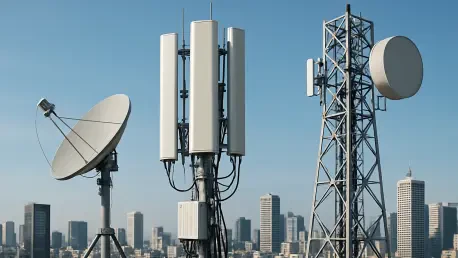The wireless antenna market is experiencing a remarkable surge, driven by the rapid deployment of 5G technology and the exponential expansion of the Internet of Things (IoT), fundamentally reshaping the landscape of global connectivity. As the foundation of modern communication networks, antennas play an indispensable role in meeting the escalating demand for high-speed, reliable data transmission that underpins a wide array of applications, from smart homes and connected vehicles to sprawling industrial systems. This growth is not merely a passing phase but a profound shift, fueled by a worldwide appetite for seamless, data-heavy networks capable of supporting the digital era’s relentless pace. The transformation is evident as industries and consumers alike push for infrastructure that can keep up with ever-evolving technological needs, positioning the wireless antenna sector at the forefront of a connectivity revolution that promises to redefine how the world interacts and operates in an increasingly interconnected environment.
Forces Fueling Market Expansion
The rollout of 5G technology stands as a pivotal catalyst for the wireless antenna market’s explosive growth, with its higher frequency bands such as millimeter-wave and sub-6 GHz delivering unprecedented data speeds and capacity to meet modern demands. These advanced bands, while revolutionary, necessitate a significantly denser network of antennas to ensure comprehensive coverage, especially in urban centers where connectivity demands are highest. This requirement has sparked a surge in demand for cutting-edge antenna solutions that can support the intricate infrastructure of 5G, driving manufacturers to scale up production and innovation. Beyond speed, 5G enables a new era of applications, from augmented reality to autonomous vehicles, all of which rely on robust antenna systems to function effectively. This push is reshaping the market, as stakeholders race to deploy solutions that can handle the unique challenges posed by these high-frequency spectrums, ensuring that connectivity remains uninterrupted across diverse environments.
Complementing the 5G wave, the IoT revolution is another powerful driver, connecting billions of devices ranging from household gadgets to industrial sensors, each requiring dependable communication channels to operate seamlessly. This proliferation of connected devices places immense pressure on existing networks, amplifying the need for advanced antenna systems capable of managing massive machine-type communications without compromising performance. The sheer scale of IoT adoption, spanning sectors like healthcare, agriculture, and logistics, underscores the urgency for scalable, efficient antenna designs that can support this interconnected ecosystem. As smart cities and automated industries become more prevalent, the role of antennas in facilitating real-time data exchange grows ever more critical. This dual force of 5G and IoT is not just expanding the market but also redefining its priorities, pushing for solutions that balance capacity with reliability in an increasingly complex digital landscape.
Cutting-Edge Innovations Shaping the Industry
At the core of the wireless antenna market’s evolution lies a wave of technological advancements, with innovations like beamforming, multiple-input multiple-output (MIMO), and phased array systems setting new benchmarks for network performance across diverse applications. These technologies enhance signal strength and adaptability, allowing networks to dynamically adjust to varying conditions, whether in crowded urban settings or remote areas with sparse infrastructure. Beamforming, for instance, directs signals precisely to users, reducing interference and boosting efficiency, while MIMO multiplies data capacity by utilizing multiple antennas simultaneously. Such breakthroughs are essential for meeting the rigorous demands of 5G and IoT, ensuring that connectivity remains robust even under heavy load. As a result, these advancements are not just improving current systems but also laying the groundwork for future network capabilities that can handle even greater complexity.
Beyond performance, the industry is witnessing a shift toward compact and multifunctional antenna designs, driven by the need for network densification in tightly packed urban environments where space is at a premium. These smaller, versatile antennas are engineered to integrate seamlessly into existing infrastructure, supporting the dense deployment required for 5G while minimizing visual and spatial impact. Additionally, sustainability has emerged as a key focus, with manufacturers developing modular and eco-friendly designs that reduce environmental footprints through energy efficiency and recyclable materials. This emphasis on green technology reflects a broader industry trend toward aligning with global environmental goals, ensuring that growth does not come at the expense of ecological responsibility. Together, these innovations highlight a market that is not only responding to immediate needs but also anticipating future challenges with forward-thinking solutions that prioritize both functionality and sustainability.
Versatility Across Applications and Segments
The wireless antenna market showcases remarkable diversity through its array of product types, including directional, omnidirectional, sector, and patch antennas, each designed to address specific communication needs in varied settings. Directional antennas, for example, excel in point-to-point connections, ideal for long-distance data transfer, while omnidirectional models provide broad coverage, perfect for public spaces like stadiums or shopping centers. This variety ensures that solutions are tailored to unique challenges, whether delivering targeted signals or blanketing large areas with connectivity. Such adaptability is crucial in a world where communication demands differ vastly between urban high-rises and rural landscapes, allowing the market to cater to a wide spectrum of users. As industries continue to digitize, the ability to offer specialized antenna types becomes a competitive advantage, meeting the nuanced requirements of modern connectivity with precision.
Equally diverse are the deployment modes, which range from indoor installations in offices and data centers—think ceiling or wall-mounted units—to outdoor setups on rooftops, poles, and towers that provide expansive network backhaul across regions. Indoor solutions focus on localized coverage, ensuring seamless connectivity in confined spaces, while outdoor deployments tackle the challenge of wide-area access, often under harsh environmental conditions. This flexibility in deployment enables the market to address the full spectrum of connectivity needs, from personal use in homes to critical infrastructure in industrial zones. The ability to customize antenna placement based on environmental and operational factors underscores the market’s capacity to evolve alongside technological and societal shifts. As connectivity becomes a cornerstone of daily life, this segmented approach ensures that no area or application is left behind, reinforcing the industry’s role as a universal enabler of digital progress.
Regional Dynamics and Emerging Opportunities
Geographically, the wireless antenna market reveals striking disparities in growth and potential, with Asia-Pacific emerging as a dominant force thanks to aggressive investments in wireless infrastructure and ambitious smart city initiatives in countries like China, India, and Japan. Government incentives and a burgeoning startup ecosystem in the region further accelerate progress, creating a fertile ground for innovation and deployment at an unmatched scale. The rapid urbanization and population density in these countries amplify the need for advanced antenna systems to support dense, high-traffic networks, making Asia-Pacific a critical hub for market expansion. This momentum is complemented by a strong focus on integrating 5G and IoT into national development plans, positioning the region as a leader in shaping the future of connectivity. As such, Asia-Pacific not only drives current growth but also sets a precedent for how strategic policies can catalyze technological advancement on a massive scale.
In contrast, North America and Europe sustain robust demand through their well-established wireless networks and ongoing efforts to densify 5G infrastructure, ensuring they remain at the cutting edge of connectivity solutions. These regions are also pivotal centers for research and development, where major industry players allocate significant resources to pioneer next-generation antenna technologies that set global standards. The mature markets in these areas provide a stable foundation for testing and scaling innovations, often serving as proving grounds for solutions that later expand worldwide. Additionally, the regulatory frameworks and consumer expectations in North America and Europe push for high-quality, reliable systems, fostering an environment where performance and efficiency are paramount. This blend of maturity and innovation ensures that these regions continue to play a vital role in the market’s evolution, balancing steady growth with groundbreaking advancements that influence industry trends globally.
Competition and Market Leadership
The competitive landscape of the wireless antenna market is characterized by a dynamic interplay between global giants and agile startups, resulting in a moderately consolidated yet highly innovative environment that drives continuous progress. Industry leaders such as Huawei, Cisco, Ericsson, and Qualcomm maintain dominance through relentless product development, strategic alliances, and expansion into emerging markets, consistently delivering high-performance solutions that meet evolving demands. Their ability to invest heavily in research and adapt to technological shifts allows them to stay ahead, setting benchmarks for quality and efficiency that shape market expectations. This leadership is not just about scale but also about foresight, as these companies anticipate future connectivity needs and develop antennas that support next-generation applications. Their influence extends beyond products, often guiding industry standards and fostering ecosystems where innovation thrives.
This intense competition fuels rapid technological advancements, ensuring that customer needs for energy-efficient, high-capacity systems are met with cutting-edge offerings that push the boundaries of what’s possible. The rivalry also encourages collaboration, with companies frequently partnering to combine expertise and penetrate untapped regions, thereby broadening access to advanced antenna solutions. Startups, meanwhile, inject fresh ideas and niche innovations, challenging established players to remain agile and responsive to market shifts. This blend of competition and cooperation creates a vibrant market where progress is constant, and solutions are continually refined to address the complexities of modern communication networks. As a result, the industry benefits from a cycle of innovation that not only addresses current challenges but also prepares for future demands, ensuring that the wireless antenna market remains a cornerstone of global connectivity for years to come.
Reflecting on a Transformative Era
Looking back, the wireless antenna market underwent a profound transformation, propelled by the widespread adoption of 5G technology and the staggering rise of IoT, which together redefined the benchmarks of connectivity across industries. Innovations in beamforming, MIMO, and sustainable designs emerged as critical milestones, addressing the dual imperatives of performance and environmental responsibility with remarkable ingenuity. Regional disparities, from Asia-Pacific’s rapid infrastructure growth to North America and Europe’s focus on technological leadership, painted a picture of a market that was as diverse as it was dynamic. The competitive drive among industry giants and emerging players alike fostered an environment of relentless advancement, ensuring that solutions evolved in step with global needs. Moving forward, stakeholders must prioritize sustained investment in smart technologies and scalable systems, while exploring collaborative models to bridge connectivity gaps worldwide, ensuring that the momentum of this era continues to shape a seamlessly connected future.









